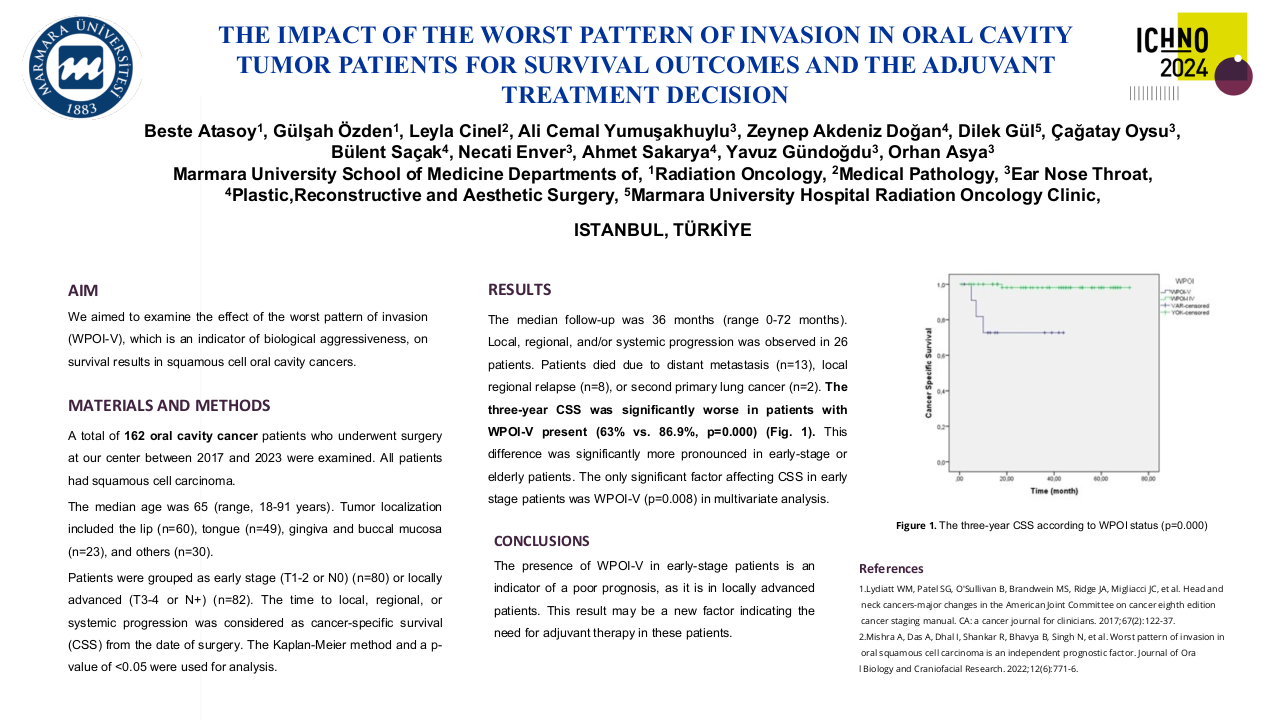Reirradiation With Stereotactic Ablative Radiotherapy In Recurrent Head And Neck Cancers
Purpose/Objective
Reirradiation has been identified as a viable treatment modality for patients with recurrent head and neck cancer (rHNC). Retrospective series demonstrate the superiority of intensity-modulated radiation therapy (IMRT) over stereotactic ablative radiotherapy (SABR) for patients in the Multi-Institution Reirradiation Collaborative (MIRI) class 2 risk group (treatment interval > 2 years without resection or treatment interval ≤ 2 years without organ dysfunction). he objective of this study was to investigate the efficacy and toxicity of SABR in patients classified as "RPA Class 2" rHNC.
Material/Methods
The data of 85 cases diagnosed with rHNC who underwent reirradiation with the SABR technique between 2007 and 2022 in our department were evaluated retrospectively. We did not incorporate cases of primary nasopharynx cancer due to its comparatively more favorable prognosis in relation to other types of head and neck cancers. The Kaplan-Meier method was used for survival analyzes (IBM SPSS v23).
Results
Patient, tumor and treatment characteristics are presented in Table 1. The median age was 59 (range, 19-87). The median follow-up period was 12 months (range,1-178 months). The first assessment following SABR revealed that 30% of the patients achieved a full response, 35% achieved a partial response, 11% had stable disease, and 4% experienced disease progression. During follow-up, local recurrence (LR) developed in 31 patients (36%) and distant metastasis (DM) developed in 24 patients (28%). The local control (LC) rate with SBRT was 64%. The most common sites of DM are the lung, bone, and liver. In 31 patients who developed LR after SABR, the median time to LR development was 8 months (range, 2-55 months). Subsequently, a third course of radiation therapy (RT) was administered to 16 of them (52%). The 1- and 2-year overall survival (OS), local recurrence-free survival (LRFS) and distant metastasis-free survival (DMFS) rates were 50% and 30%, 39% and 21%, 46% and 27%, respectively. In univariate analysis, age (≤59 vs. >59 years), gender (male vs. female), interval between treatments (≤2 vs. >2 years), organ dysfunction before SABR (present vs. absent) or surgery (present vs. absent), SABR dose (≤30 vs. >30 Gy), technique (robotic vs. linear accelerator-based), recurrent tumor volume (≤43 vs. >43 cc), and recurrence location (primary vs. neck ) parameters did not have prognostic effect on OS, LRFS and DMFS. The rate of grade 3 or 4 late toxicity was 11%, and the rate of grade 5 toxicity was 9%. Eight patients (9%) developed massive hemorrhage secondary to carotid blow out syndrome (CBOS), 6 patients (7%) developed brain parenchymal necrosis, 2 patients (2.5%) required permanent gastrostomy, and 1 patient (1.5%) developed optic neuropathy and vision loss. The administration of SABR in consecutive or alternate day fractions shown comparable effects on toxicity.
Table 1. Patient, tumor, and treatment characteristics
| Characteristic |
Number of Patients (n=85, %) |
|
Gender Male Female |
54 (64) 31 (36) |
|
Tumor location Paranasal Sinus Larynx & hipopharynx Oral cavity Salivary Gland Tumor Oropharynx Other |
20 (24) 25 (30) 15 (18) 15 (18) 6 (6,5) 4 (3,5) |
|
Interval between RT’s (median) <2 year ≥2 year |
26 months (4-301 months) 39 (46) 46 (54) |
| RT dose, median (range) / fractions, median (range) |
66 Gy (30-72 Gy) / 30 (5-33) |
|
Recurrence location Primary Neck Primary and neck |
67 (79) 11 (14) 3 (3) |
| SABR dose / fractions (median) |
30 Gy (15-50 Gy)/ 5 (1-6) |
|
SABR technique CyberKnife© Novalis® Linac (VMAT) |
61 (72) 12 (14) 12 (14) |
|
Fractionation Consecutive days Every other day |
21 (25) 64 (75) |
| GTV volume, median (range) |
43 cc (1.7-214 cc) |
|
Treatment outcomes Complete response Partial response Stabile disease Progression Unknown |
26 (30) 30 (35) 11 (13) 4 (3.5) 14 (16.5) |
Conclusion
The utilization of the SABR as a method of reirradiation in rHNC patients has demonstrated favorable outcomes in terms of achieving effective LC while maintaining acceptable levels of treatment-related toxicity. We provide a study that demonstrates highly favorable survival outcomes with SABR for patients classified as RPA class 2 rHNC. There is a need for prospective randomized studies to be conducted in order to ascertain the ideal approach for reirradiation, specifically comparing SABR and IMRT. These studies would also help identify the patient population that would benefit the most from such reirradiation techniques.






